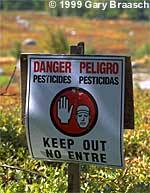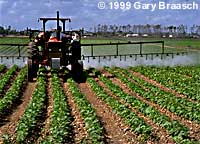“I guess you must be in favor of pesticides,” concluded a Monsanto public relations guy, after I objected to his company’s genetically engineered potato.

“I guess it’s okay with you if people starve,” said a botanist I deeply respect, with whom I have carried out a fervent argument about genetic engineering.
Accusations like these astonish me. I’m an organic farmer; I’m not in favor of pesticides. I’ve spent decades working to end hunger; it is not okay with me that anyone starves. I believe that my two accusers and I are working toward exactly the same goal — feeding everyone without wrecking the environment. We would all label that goal “sustainable agriculture.” But we must be making radically different assumptions about what that goal looks like and how to get there from here.
The idea that if I oppose genetic engineering, I must favor pesticides, arises from an assumption that those are the only two choices. If they were, I would probably agree that it’s better to fool with genomes than to spray poisons over the countryside. But I see other choices. Plant many kinds of crops and rotate them, instead of one or two crops year after year, which make a perfect breeding ground for pests. Build up ecosystems above ground and in the soil so natural enemies rise and fall with the pests, searching and destroying with a specificity and safety and elegance that neither chemicals nor engineering can match.
These are pest control methods based not on chemistry or genetics, but on ecology. They work. I know. I use them. I know dozens of organic farmers who use them. Small scale and large. Northeast, South, Midwest, West. Apples, lettuce, potatoes, strawberries, broccoli, rice, soybeans, wheat, corn.
The claim that we need genetic engineering to feed the hungry must be based on two assumptions: first that more food will actually go to hungry people, second that genetic engineering is the only way to raise more food. I assume, to the contrary, that more food will not help those who can’t afford to buy or grow it, especially if it comes from expensive, patented, designer seed.
Furthermore, more food is not needed. We already grow enough to nourish everyone. If just one-third of the grain fed to animals went to humans instead, we would not have 24,000 deaths per day due to hunger. Or if 40 percent post-harvest loss rates in poor countries were reduced. Or if we shared the embarrassing crop surpluses of North America and Europe. Or if we created an economy where everyone had money to buy food or land to grow it — which would solve a lot of other problems too.

Where, when, or if more food is needed, there are ways to produce it that don’t require biotech or chemicals. Folks with an industrial ag mindset assume that organic agriculture would cut yields. Not only is there no evidence for that assumption, there are numerous studies to the contrary. One of the latest appeared in Nature last year; its summary opens like this: “In comparison with conventional, high-intensity agricultural methods, ‘organic’ alternatives can improve soil fertility and have fewer detrimental effects on the environment. These alternatives can also produce equivalent crop yields to conventional methods.”
Imagine what yields could be if even one-tenth as much research effort were put into organic farming as has been put into chemicals or genetics.
When I show this evidence to proponents of high-tech farming, when I offer to take them to see organic farms, when I point out that hunger could be ended by sharing food or technologies that raise output without poisoning the earth or invading the genome, I don’t think my argument even reaches their auditory nerves, much less their brains. That kind of extreme failure even to hear an argument, much less process it, alerts me that this is not a rational discussion. It is a worldview difference, a paradigm gap, a disagreement about morals and values and identities and fundamental assumptions about the way the world works.
I assume the world works by the laws of ecology and economics and human nature. Ecology says that monocultures breed pests; that chemicals upset soil ecosystems and kill off natural predators; that crops with pesticide in every cell will induce pest resistance; that animals and plants should be grown in close proximity so manure can go back to the soil; and that we haven’t the slightest idea what the ecological or evolutionary consequences of genetic engineering will be.
Economics says you can never have a sustainable market if you produce something consumers fear and you hide critical information about how it was produced and what it contains. Because industrial agriculture has violated that law and lost the trust of consumers, the market for organic produce is growing in American and Europe by 20 to 30 percent per year, even with a price premium; it now totals over $9 billion.
Human nature says the more actual producers can own and shape and control land and inputs and seeds and knowledge, the more inventive, adaptive, and equitable agriculture will be.
Acceptance of those laws shapes my vision of sustainable agriculture. I picture healthy ecosystems and healthy human beings working together in thriving, close-knit communities. Farms are small, owner-operated, with what Wes Jackson calls a “high eyes-to-acres ratio,” which means they are well managed and high-yielding. Farmers make more use of knowledge and people than of chemicals and seeds they can’t breed for themselves. Animals are raised on all farms; there are good reasons why ecosystems don’t concentrate all the plants in one place and all the animals in another.
Food is grown everywhere, in cities, in suburbs. The distance from producer to consumer is short, there are fewer supermarkets, more farmers markets, less packaging, more freshness. The principle of one of my favorite organic farmers permeates the system: “I’m not growing food, I’m growing health.”
To those who do not believe such a vision is possible, I can only say: It exists, it’s alive and well and growing, it’s even more profitable than the industrial vision, the food tastes better, the work is more pleasurable. I live in this vision. I have friends all over the world who live in it. Come see.


